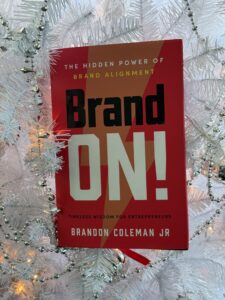Potholes take your car out of alignment. Hit just one pothole at speed and your car begins to wobble. Drive bumpy roads consistently, and your car will struggle to perform at its best.
Likewise, your business hits potholes for various reasons, and they will take your brand out of alignment. Over 50 years of consulting, I kept a running list of the potholes most entrepreneurial enterprises hit, and seven of them come up time and time again.
Here are the Top 7 Potholes that may be giving your business a bumpy ride. My assumption is that you will find one or more that hits close to home, but more often than not, they sneak up on leaders. Keep in mind that this is not a comprehensive list of every underlying reason a brand gets knocked out of alignment, but they are the most recurring.
Internal Marketing Employees
At first, it may seem hard to believe your brand’s biggest enemy may well be your own internal marketing person or team of people, but it’s true, especially in entrepreneurial enterprises.
The main reason internal marketing employees are often the biggest pothole in the road is quite simple; their job and their paycheck depend on your happiness. That may sound obvious, but they work to please the entrepreneur, and they can read the room. They know full well the things you like and don’t like. They grasp your propensity to select one strategy or tactic over another, and at the end of the day, you are the boss.
Many critical marketing and branding decisions are compromised in this manner, resulting in an overall program that is, quite frankly, very mediocre. Sure, there might be moments of brilliance, but evaluated over the long term, you are most certainly not maximizing your potential.
These team members may also be driven by a natural pride of authorship and the desire to maintain their status as key contributors, possibly resulting in choices that compromise the brand’s integrity or strategic direction, ultimately creating more challenges than solutions.
In many instances, they cause a pothole by sheer lack of relevant experience or the fact they are not strategic business thinkers and are much more comfortable in the deployment of marketing tactics. I go into this common pothole at length in my new book.
External Marketing Vendors
External marketing vendors, like their internal counterparts, can also create significant challenges. We all aim to please but external vendors usually have the big sale in mind over what’s right for your brand. Their hearts may be in the right place, but the goal of increasing sales can sometimes lead to unnecessary recommendations that do not align with your brand’s best interests. This happens quite frequently in the marketing world.
A case in point involved a $20 million business I recently helped with a successful rebrand. Upon completion of the project, everything was launched in perfect order and the immediate results were staggering. However, shortly after the launch, a radio media salesman persuaded the internal marketing director to change their highly successful radio spots, even though they had only been live for 30 days.
Influenced by the convincing vendor’s ability to sell, they created new spots. Ultimately, the spots were a disaster and fortunately, never ran. When they called me with the story, I simply asked if they had inquired how many brands this radio rep had created and launched in his life. The call went silent, underscoring my personal practice of being judicious with external vendors and recognizing their primary motivation, which may or may not be in alignment with yours.
The Owner’s Forest
Entrepreneurs and professionals often find themselves too deeply immersed in their own ventures to maintain objectivity, making it difficult to recognize areas where their brands may need adjustment. Having such close ties with a brand makes it challenging for them to see their brand from an outsider’s perspective, often resulting in misaligned strategies.
As examples, an engineer may assume everyone understands the technical marvel they just created, and because of such, he or she also knows exactly how to position the brand. Or the good doctor, accustomed to so much success in their field, they may well resist advice on their branding initiatives.
This pothole shoves brands out of alignment and owners won’t be able to get it back in line until they step out of the forest to see the bigger picture of the dying trees. Looking at the issues from a different perspective allows them to take the proper steps to align their brand more effectively with market perceptions and customer expectations.
Personal Pride and Success
Personal pride naturally compels many business owners to create their own brands. Perhaps their daughter, son, or wife had the idea. It becomes a cocktail topic at the bar and gives business leaders bragging rights. Sometimes these owners’ entrepreneurial instincts are so strong they nail it, but most of the time, they don’t.
Pride also gets entrepreneurs when they see their own marketing work out in the public eye. It’s a rush to lay claim to a brand, marketing, or advertising idea that everyone can see. Whether it’s a billboard, a product package at the store, a Facebook ad, or just a graphic on a banner at the company picnic, it feels all warm inside for the person who believes they created it. It is one of the reasons social media has taken off like it has. Everyone gets to be a creator, writer, designer, publisher, broadcaster, or influencer. People get a huge rush out of seeing their own work on the screen, regardless of how good it is—or is not.
Success is often a major personal pride pothole on the road to brand alignment. Most of our brand alignment projects are not about helping failing companies; rather, they’re about maximizing the potential of already successful ones.
That’s why the initiatives usually include overcoming the virtues and challenges of that existing success. Breaking brand paradigms is usually easier in a struggling company than it is in a successful one, because the leaders, on average, are ready to listen. Small business leaders already experiencing financial success tend to be a bit more guarded in their approach to new ideas relating to brand alignment.
To maximize potential, leaders must be willing to embrace fresh perspectives and adjust to align with market demands. Use your past success to drive innovation, not tie it down to the past.
Wrong Brand Concept
There are so many things to consider when starting or growing a business. Many times, leaders feel like brand is something secondary to engineering, production, finance, or human resources. Sometimes, entrepreneurs do not have the time or the contacts they really need to launch their brand, so they either table it for later or reach out to their easiest access point.
I’ve seen one business use a failing brand name for six years because it seemed the easy way to move forward. However, once they addressed the brand name and made the proper course corrections, their results were quick and significant.
If you acquire a company or take a position in a company you did not create, you may not have had a choice in the brand, so you are saddled with the challenge of leveraging a brand that may not have been right from the start. Don’t let that sway you. You may have to address the board of directors, a partner, or investors, but address them you should, so you can do what you need to do to get the brand in alignment.
Compromising to Please Others
Everyone, from family members to employees, have opinions about how a business should be branded.
The last thing you want to do as a business owner is compromise your branding to please other voices. Yes, seeking input is a valuable part of the process, but attempting to align a brand based on a myriad of outside voices usually leads to an extremely mediocre, or even disastrous, outcome.
Rather than trying to please everyone, focus on your own expertise and what you and your experienced brand creators can bring to the branding process. As the leader, use your entrepreneurial gut instinct and make the big decisions that are best for your brand, even if it means not every stakeholder at the table will be satisfied.
Know that great branding is never achieved by committee; it requires decisive leadership and a clear vision.
Unintentional Morphing
It is uncanny how often this seventh pothole blows out tires.
This common, yet subtle, pothole is one that can lead even the most successful organization down the wrong road. What’s scary about unintentional morphing is how gradually it can happen and how easily it goes unnoticed until it’s too late and your brand is being outperformed by your competitors.
How do you know if your brand has fallen victim? Are you constantly making changes in an attempt to find the right mix? Do team members describe your brand inconsistently and confuse customers? Is your delivery consistent with your desired customer journey?
All of these issues point to unintentional morphing which has evolved over time from inside your organization and made its way to the face your audience sees. Look around your enterprise and determine if you have aligned the brand intentionally, or if it has morphed into something you don’t recognize.
Avoid the Potholes and Turn Your Brand ON!
We have just touched the tip of the iceberg in this article. If you want to further explore these potholes and get a full grasp of all the nuances that can take your brand out of alignment, check out my new book Brand ON! It will be available for pre-order on Amazon or your favorite book sources on November 14 and will officially publish for delivery in January 2025. Don’t forget to tune in to The BRAND ON! Show, a podcast we drop every Tuesday morning.


